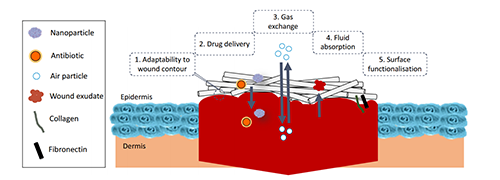Copyright © 2022 Foshan MBRT Nanofiberlabs Technology Co., Ltd All rights reserved.Site Map
Wound healing is a highly regulated process composed of four overlapping phases: (1) coagulation/haemostasis, (2) inflammation, (3) proliferation and (4) remodelling. Comorbidities such as advanced age, diabetes and obesity can impair natural tissue repair, rendering the wound in a pathological state of inflammation. This results in significant discomfort for patients and considerable financial costs for healthcare systems. Due to the complex nature of wound healing, current treatments are ineffective at dealing with delayed healing. With flexible properties that can be tailored, nanomaterials have emerged as alternative therapeutics for many biomedical applications. A nanofibrous network can be made via electrospinning polymers using a high electric field to create a responsive meshwork that can be used as a medical dressing. A nanofibrous device has properties that can overcome the limitations of traditional dressings, such as: (1) adaptability to wound contour; (2) controlled drug delivery of therapeutics; (3) gaseous exchange; (4) exudate absorption and (5) surface functionalisation to further enhance the biological activity of the dressing. This review details emerging trends in nanotechnology to specifically target wound healing applications. Particular focus is given to the most common natural polymers that could address many unmet healthcare needs.

Published:2021
Journal:Materials Science & Engineering C-Materials for Biological Applications
Impact Factor:5.880
Paper link:https://www.sciencedirect.com/science/article/abs/pii/S0928493120307839